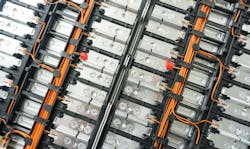How to Achieve Precision Production of Lithium-Ion Batteries for EVs
Ten years ago, the market for personal electric vehicles (EVs) was nearly nonexistent. Now, the transportation industry is traveling toward an electric-fueled future.
According to a recent report from the International Energy Agency, 1.4 million cars registered in Europe in 2020 were electric, a 10% share of total vehicle sales. In China and the U.S., that figure was 6% and 2%, respectively. This industry’s growth and the increased number of people buying EVs can be attributed to several factors, including government policies to bolster alternative energy technologies, as well as the greater range and power of new EV models.
The technology driving the EV revolution is the lithium-ion (Li-ion) battery. The powerhouse of a battery is an electrochemical cell, which is made of anode and cathode materials supported on charge-carrying electrodes, an electrolyte often containing lithium hexafluorophosphate (LiPF6) with a mixture of organic carbonate solvents, and a separator that lets the lithium ions migrate between the anode and cathode during battery charge and discharge.
Engineering improvements over the past two decades have boosted the energy density of a cell, packing more energy in an ever-smaller container. These design improvements, combined with automated techniques for precision mass manufacturing, have caused prices for Li-ion batteries to drop 89% in the past decade.
The manufacturing process for Li-ion batteries destined for small consumer electronics is well established, but producing Li-ion batteries for EVs has introduced new demands for manufacturers. Their equipment and workflows are similar, but “automotive cells do require higher quality batteries and controls than smaller devices do,” according to Marc Locke, chair for production engineering of e-mobility components at RWTH Aachen University.
A single EV lithium-ion battery pack contains hundreds of individual cells wired together. A single flaw in only one of these cells can reduce performance and cause internal short circuits that could ignite a battery’s flammable electrolyte. “Internal shorts in cells are what keep battery engineers up at night,” says Andrew Jansen, a chemical engineer and group lead for the Cell Analysis, Modeling, and Prototyping (CAMP) Facility at Argonne National Laboratory. “It’s a tremendous amount of energy in a little space.”
To ensure that Li-ion batteries for EVs fulfill performance and safety requirements, battery manufacturing processes must meet narrow precision thresholds and incorporate quality control analyses that are compatible with a high-throughput, automated production line. It takes days to get a battery in a workable state to do performance tests, so quality control during production is key for success.
What You'll Learn:
- Meeting the Quality Control Challenge
- Preparing the Electrodes
- Assembling the Battery Cells
- Finishing the Battery Assembly
- Future EV Battery Technologies
